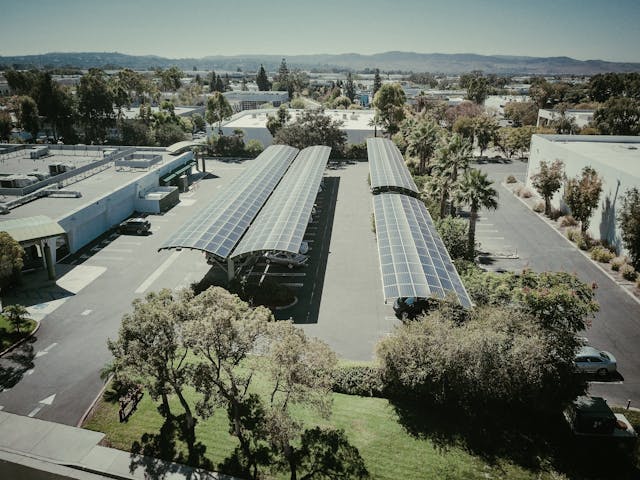
Empowering Industrial Decarbonization with Advanced Solar Solutions
Key Takeaways:
- Leverage Commercial Rooftop Solar and Industrial PV Systems: Adopt advanced solar technologies to reduce operational costs and carbon emissions effectively.
- Incorporate Commercial Solar Battery Storage: Utilize battery energy storage systems to enhance financial viability and generate additional revenue from flexibility markets.
- Secure Energy Price Stability: Install on-site solar power systems to fix long-term electricity prices and protect against market volatility and supply disruptions.
- Explore Flexible Financing Options: Consider leasing or renting solar installations to achieve immediate cost savings without upfront capital investment.
- Optimize Asset Utilization: Valorize unused rooftop spaces by installing solar panels, thereby enhancing property value and contributing to sustainability goals.
The industrial sector stands at a critical juncture in the global pursuit of sustainability. As pressure mounts to reduce carbon emissions and transition to cleaner energy sources, industries face the dual challenge of maintaining operational efficiency while meeting environmental obligations. Advanced solar solutions, particularly commercial rooftop solarand industrial PV systems, offer a viable pathway to achieve these goals.
The Rise of Commercial Rooftop Solar and Industrial PV Systems
Recent years have witnessed a significant decline in the costs associated with photovoltaic (PV) technologies. According to the International Renewable Energy Agency (IRENA), the global weighted-average levelized cost of electricity (LCOE) from utility-scale solar PV fell by 85% between 2010 and 2020. This dramatic cost reduction has been driven by technological advancements, economies of scale, and improved manufacturing processes.
For industrial players, this means that investing in large-scale solar energy solutions is not only environmentally responsible but also economically advantageous. The Fraunhofer Institute for Solar Energy Systems reports that industries adopting PV have achieved energy cost savings of up to 30%, enhancing their competitiveness in a rapidly evolving market.
The Essential Role of Solar Battery Storage
With the increasing integration of PV systems into the grid, the incorporation of commercial solar battery storage has become indispensable. Batteries are crucial for countering the capture rate—the price reduction linked to the abundance of solar energy at some times. By adding a battery energy storage system (BESS), industries can ensure the financial viability of their solar projects by storing excess energy and using it during peak demand periods.
Moreover, BESS enables participation in flexibility markets, generating additional revenue streams. Industries can offer stored energy back to the grid during high-demand periods, optimizing their energy management and contributing to grid stability.
Hedging Against Energy Price Volatility
Energy price fluctuations pose significant risks to industrial operations. The Ukraine crisis in 2022 underscored the vulnerability of relying solely on external energy supplies. By installing solar power systems for businesses on-site, industries can fix their electricity prices over a long period, insulating themselves from market volatility and potential supply disruptions.
This strategic move not only ensures energy security but also allows for more accurate long-term financial planning. The International Energy Agency (IEA) emphasizes that renewable energy sources like solar PV can mitigate risks associated with energy costs and supply, enhancing overall operational resilience.
Flexible Financing: Leasing and Renting Options
One of the barriers to adopting renewable energy solutions has been the significant upfront capital investment required. However, innovative financial models now allow industries to lease or rent solar installations, eliminating the need for initial capital outlay. This approach enables businesses to save money from day one, with cash flows similar to existing expenditures but at a reduced cost.
Leasing options provide immediate financial benefits, as highlighted in the World Business Council for Sustainable Development’s report on industrial solar energy strategies. Companies can achieve significant cost savings without impacting their capital budgets, making the transition to renewable energy more accessible.
Maximizing Asset Value: Valorizing Your Roof
Industrial facilities often have extensive rooftop spaces that remain underutilized. Installing commercial rooftop solar systems allows businesses to capitalize on this asset, turning rooftops into energy-generating platforms. This not only contributes to sustainability goals but also enhances property value and can offer a competitive edge.
The European Commission’s guidelines on renewable energy self-consumption highlight the benefits of utilizing existing infrastructure for energy generation. By valorizing rooftop spaces, industries can optimize their physical assets while contributing to a greener future.
Choosing the Right Partner for Your Decarbonization Journey
Successfully navigating the transition to renewable energy requires expertise, advanced technology, and flexible financial solutions. The ideal partner should offer:
- Expert Guidance: Tailored decarbonization strategies that align with your specific operational needs.
- Advanced Technologies: Access to the latest and most reliable solar PV and battery storage solutions.
- Flexible Financing: Custom financial models that eliminate upfront costs and improve cash flow.
- Comprehensive Support: End-to-end services from consultation to maintenance, ensuring project success.
By collaborating with a partner that embodies these qualities, industries can confidently embark on their decarbonization journey, reaping the economic and environmental benefits of advanced solar solutions.
Conclusion
The imperative for industrial decarbonization is clear, and the means to achieve it are within reach. Advanced solar solutions, encompassing industrial PV systems and commercial solar battery storage, provide a practical and profitable pathway to sustainability. By embracing these technologies, industries can reduce operational costs, enhance energy security, and contribute significantly to global emission reduction efforts.
As the landscape of energy continues to evolve, now is the time for decision-makers to act. By choosing the right partner and leveraging innovative solar solutions, industries can position themselves at the forefront of the sustainable energy revolution.
For further reading on the benefits and strategies of integrating solar solutions into industrial operations, consider exploring reports by reputable organizations such as IRENA, Fraunhofer ISE, and the International Energy Agency.

